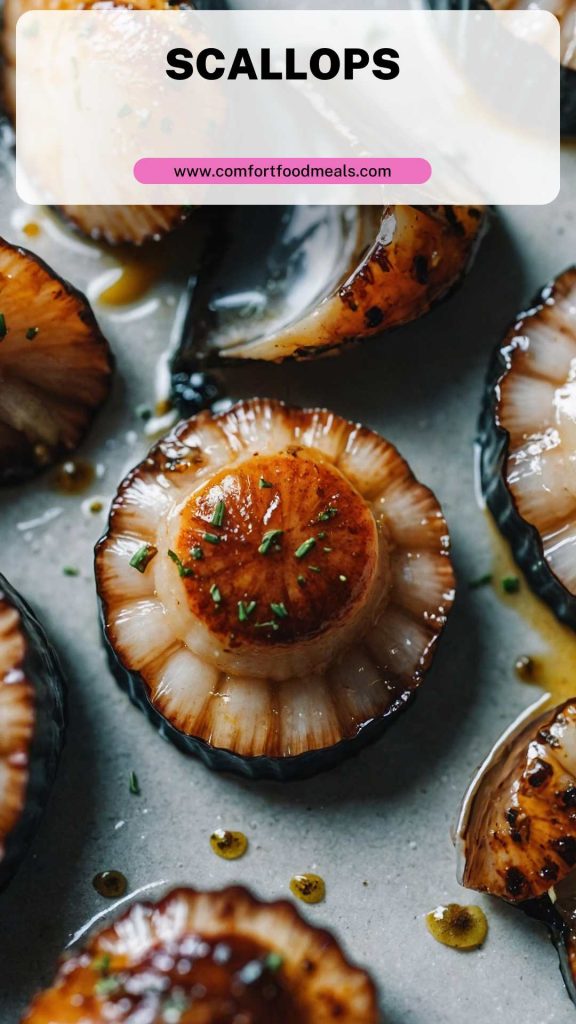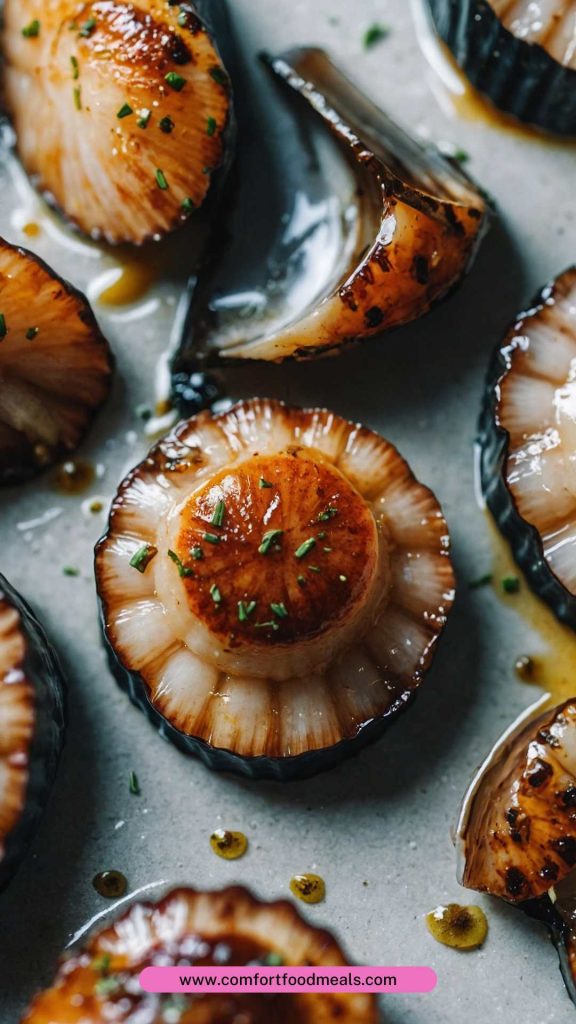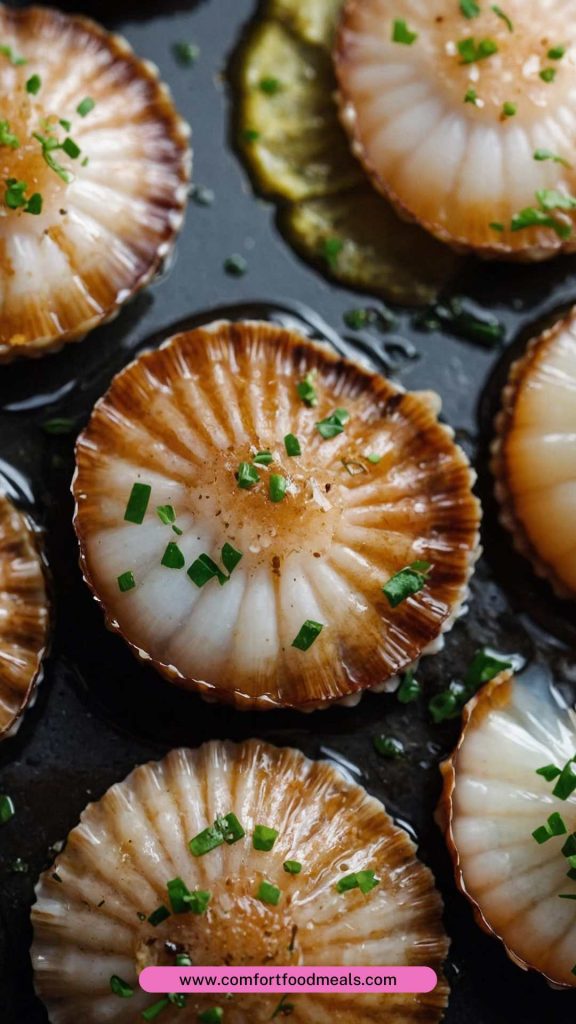Nutrition Facts
Servings 5
- Amount Per Serving
- Calories 90kcal
- % Daily Value *
- Total Fat 1g2%
- Protein 17g34%
* Percent Daily Values are based on a 2,000 calorie diet. Your daily value may be higher or lower depending on your calorie needs.

When it comes to seafood, few dishes are quite as luxurious as scallops. Their delicate flavor and tender texture make them a sought-after choice, whether you're dining at a fine restaurant or cooking at home. Today, I’ll share my experience and insights into preparing scallops, along with tips, tricks, and even some great pairings. Trust me, after this, you’ll be ready to impress family and friends with this incredible seafood.
Before diving in, let’s talk about what to serve with scallops. The right companions can elevate your dish to new heights. Consider these pairs:
1. Creamy Risotto: The rich, velvety texture of risotto complements scallops perfectly, creating a luxurious mouthfeel.
2. Fresh Greens: A light arugula or spinach salad adds crispness and balances the dish. Toss in some lemon vinaigrette for a zesty kick.
3. Roasted Vegetables: Caramelized asparagus or Brussels sprouts can enhance the flavor profile. Their earthy notes contrast beautifully with the sweetness of scallops.
4. Garlic Bread: A side of toasted garlic bread can soak up any delicious sauce you create. It’s simple but effective.
Let’s explore scallops more deeply.

Scallops are bivalve mollusks found in oceans around the world. They have two shells (like clams) but what we cook and eat is the adductor muscle—the part that enables them to open and close their shells. This muscle is what gives scallops their tender texture and sweet flavor.
Whether you encounter sea scallops or bay scallops, both varieties bring something unique to your plate. While sea scallops are larger and have a meatier flavor, bay scallops are smaller and often sweeter.
Cooking scallops can seem intimidating, but I promise, it’s easier than you think. Here’s why my method for preparing scallops works so well:
1. Quick Cooking Time: Scallops cook rapidly, usually within minutes. This means you can whip up an impressive dish in no time, perfect for busy weeknights.
2. Simple Ingredients: With just a few ingredients, you’ll let the freshness of the scallops shine through. You don’t need elaborate spices or sauces to enhance their natural sweetness.
3. A Perfect Sear: Achieving a golden-brown crust enhances flavor. This caramelization process adds depth without overwhelming the actual taste of the scallops.
4. Versatility: This recipe is flexible. Pair it with whatever sides or sauces you have on hand. You can make it your own while retaining that essential scallop goodness.
Gather these simple yet impactful ingredients:
First, rinse the scallops under cold water and pat them dry with paper towels. This step is crucial for achieving a good sear. Wet scallops will steam more than sear, which means they won’t develop that lovely crust.
Once dried, season the scallops generously with salt and freshly ground black pepper. This isn’t just for taste; it aids in developing the crust when cooking.
Add the olive oil to a skillet over medium-high heat. Let it heat for a minute until it shimmers. This indicates that the oil is hot enough for searing.
Place the scallops in the hot skillet, making sure not to overcrowd them. If your skillet is too crowded, they will steam rather than sear. Cook for about 2-3 minutes without moving them. Flip when they turn golden brown.
After flipping, add the unsalted butter and minced garlic to the pan. This will not only add richness but also infuse flavor into the scallops. Spoon the butter over the scallops as they continue to cook for another 2-3 minutes until they’re opaque and slightly firm.
Once cooked, transfer the scallops to a plate. Drizzle with the melted butter and sprinkle with fresh parsley and a squeeze of lemon juice for a zesty finish.

Here are some extra tips to make your scallop experience even better:
Choose Quality Scallops: Look for fresh or frozen scallops that are dry (not treated with preservatives). This will make a significant difference in flavor and texture.
Don’t Overcook: Scallops can go from perfectly cooked to rubbery quickly. Keep an eye on them. They should be opaque but still slightly tender in the center.
Experiment with Flavor: Don’t hesitate to try flavored oils or infuse the butter with herbs for an extra touch.
Use a Cast Iron Skillet: If you have one, it retains heat well and gives the scallops an even sear.
Practice Patience: Resist the urge to move the scallops around too much while cooking. Let them sit to get a good sear.
Scallops are not only delicious but also nutritious. Here’s a quick overview of what you get per serving (based on a 3-ounce serving):
Scallops are low in calories but high in protein, making them a perfect option for a healthy meal.

If you find yourself with leftover scallops, you can store them effectively:
However, reheating can be tricky. Use a short burst in the microwave or gently warm in a skillet to prevent them from becoming rubbery.
Enhance your scallop experience with these side dishes:
Creamy Garlic Mashed Potatoes: These add a creamy base that contrasts nicely with the scallops. They’re buttery and rich, truly comforting.
Light Citrus Salad: A salad with mixed greens, orange segments, and a light vinaigrette refreshes the palate. It balances the flavors wonderfully.
Quinoa Pilaf: Quinoa, cooked with broth and herbs, provides a nutty base that complements the sweetness of scallops. It’s hearty without being heavy.
Steamed Broccoli: With its bright color and crunchy texture, broccoli adds a nutritious component and the freshness pairs well.
Sometimes you don’t have everything on hand. Here are some alternatives:
Sea Scallops: If unavailable, bay scallops work, though they’re smaller and cook faster. Adjust your cooking time accordingly.
Extra-Virgin Olive Oil: You can use vegetable oil or avocado oil instead. Both have high smoke points and won’t overpower the dish.
Unsalted Butter: For a dairy-free option, consider using coconut oil or a plant-based butter substitute.
Fresh Parsley: If you’re out, try chives or even cilantro for a different flavor profile. Just sprinkle it fresh for garnish.
Cooking scallops may seem like a high-level culinary skill, but with the right ingredients and a few simple steps, they can become your new go-to dish. From their rich flavor to their tender texture, it’s hard to beat the satisfaction of perfectly seared scallops.
So, gather your ingredients, heat that skillet, and whip up a dish that will impress. Whether it’s for a dinner party or a quiet evening at home, scallops offer a culinary adventure. Enjoy!
When it comes to seafood, few dishes are quite as luxurious as scallops. Their delicate flavor and tender texture make them a sought-after choice, whether you're dining at a fine restaurant or cooking at home. Today, I’ll share my experience and insights into preparing scallops, along with tips, tricks, and even some great pairings. Trust me, after this, you’ll be ready to impress family and friends with this incredible seafood.
Servings 5
* Percent Daily Values are based on a 2,000 calorie diet. Your daily value may be higher or lower depending on your calorie needs.
Here are some extra tips to make your scallop experience even better:
Choose Quality Scallops: Look for fresh or frozen scallops that are dry (not treated with preservatives). This will make a significant difference in flavor and texture.
Don’t Overcook: Scallops can go from perfectly cooked to rubbery quickly. Keep an eye on them. They should be opaque but still slightly tender in the center.
Experiment with Flavor: Don’t hesitate to try flavored oils or infuse the butter with herbs for an extra touch.
Use a Cast Iron Skillet: If you have one, it retains heat well and gives the scallops an even sear.
Practice Patience: Resist the urge to move the scallops around too much while cooking. Let them sit to get a good sear.